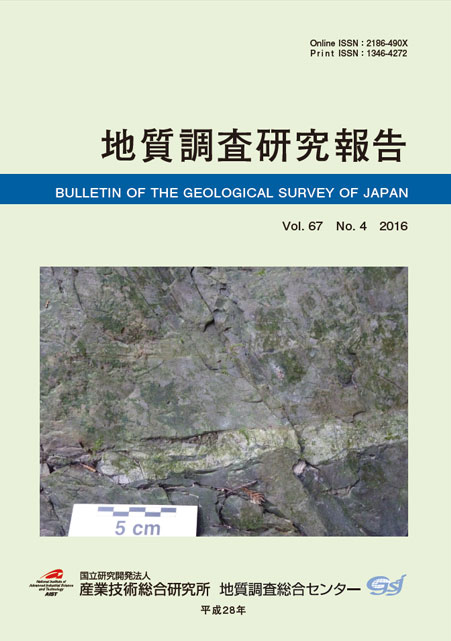
- Issue 6 Pages 183-
- Issue 5 Pages 133-
- Issue 4 Pages 101-
- Issue 3 Pages 67-
- Issue 2 Pages 41-
- Issue 1 Pages 1-
- |<
- <
- 1
- >
- >|
-
Yutaka Kanai, Yoshiko Tachibana, Masahiro Aoki, Chizuko Okazaki, Yasuy ...2016 Volume 67 Issue 4 Pages 101-110
Published: October 18, 2016
Released on J-STAGE: November 01, 2016
JOURNAL FREE ACCESSTwo specimens of fluorescent opal in the Shikaribetsu area, central Hokkaido, were studied on their chemical compositions of fluorescent layers. Some characteristic properties for their chemical compositions were elucidated, although clear relationship between chemical element and fluorescent color was not found out. They contained as much as several hundred ppm of Li, Be, Ga, As, Rb, Cs and several thousand ppm of Sb. Alkali elements (Na, K, Li, Rb, Cs) and alkali earth elements (Ca, Sr, Ba) showed relatively small variations among the parts showing different color fluorescence in one sample. Further study on organic materials is necessary for better understanding of the fluorescence phenomenon.
View full abstractDownload PDF (1933K) -
Yuki Tsunazawa, Sadahisa Sudo, Tetsuichi Takagi2016 Volume 67 Issue 4 Pages 111-117
Published: October 18, 2016
Released on J-STAGE: November 01, 2016
JOURNAL FREE ACCESSWeathered granite has been expected to be an alternative material for potteries. Weathered granite, known as “Ao-saba”, contains kaolin clay at around 10 % and this kaolin clay can be recovered by elutriation. However, elutriation residue contains colored minerals like biotite containing iron, which is not appropriate for raw materials for potteries. To use elutriation residue as raw materials, colored minerals have to be removed. This study applied classification and magnetic separation to removal of colored minerals from clayey weathered granite. Classification tests revealed that colored minerals like biotite were only contained in a smaller grain group of elutriation residue. This result meant that classification was effective for recovery of a bigger grain group of elutriation residue where colored minerals did not exist. Then, magnetic separation tests were conducted to remove biotite from a smaller grain group of elutriation residue. In magnetic separation tests, colored minerals were completely removed from any size of elutriation residue. Therefore, it was demonstrated that classification and magnetic separation were an effective method for iron removal from clayey weathered granite.
View full abstractDownload PDF (1132K)
-
Atsushi Noda, Toshiyuki Kurihara2016 Volume 67 Issue 4 Pages 119-131
Published: October 18, 2016
Released on J-STAGE: November 01, 2016
JOURNAL FREE ACCESSRadiolarian fossil analyses were conducted to determine the depositional age of the Izumi Group, eastern Shikoku. Fourteen of total 19 samples yielded radiolarian fossils. Most samples contain Dictyomitra koslovae and Amphipyndax tylotus, and do not include Clathrocyclas tintinnaeformis, Myllocercion acineton, or Clathrocyclas gravis. Those assemblages can be correlated with the Amphipyndax tylotus assemblage zone of Yamasaki (1987), the Amphipyndax tylotus interval zone of Hollis and Kimura (2001), and the Archaeodictyomitra lamellicostata zone of Hashimoto et al. (2015). Therefore, the depositional age of the Izumi Group in this district is estimated to be early Late Campanian, Late Cretaceous.
View full abstractDownload PDF (19601K)
- |<
- <
- 1
- >
- >|